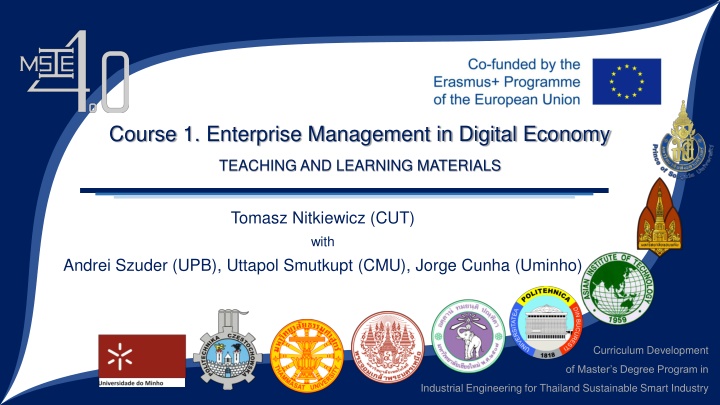
Digital Economy Management: Strategies, Innovations & Tools
Explore the impact of digital economy innovations on businesses, sustainable strategies, and competitive advantage through strategic analysis tools in this comprehensive course. Learn to adapt to the changing business landscape and succeed in the digital era.
Download Presentation

Please find below an Image/Link to download the presentation.
The content on the website is provided AS IS for your information and personal use only. It may not be sold, licensed, or shared on other websites without obtaining consent from the author. If you encounter any issues during the download, it is possible that the publisher has removed the file from their server.
You are allowed to download the files provided on this website for personal or commercial use, subject to the condition that they are used lawfully. All files are the property of their respective owners.
The content on the website is provided AS IS for your information and personal use only. It may not be sold, licensed, or shared on other websites without obtaining consent from the author.
E N D
Presentation Transcript
Course 1. Enterprise Management in Digital Economy TEACHING AND LEARNING MATERIALS Tomasz Nitkiewicz (CUT) with Andrei Szuder (UPB), Uttapol Smutkupt (CMU), Jorge Cunha (Uminho) Curriculum Development of Master s Degree Program in Industrial Engineering for Thailand Sustainable Smart Industry
Course 1. EMDE structure I. Business perspective to understand the digital economy and its influence A. How digital economy innovations and its social context impacts different types of businesses? B. Digitalization in the context of needs, markets, channels, products and services and management and organizational set-up - identification of different way digital era changes the business C. How the pace of changes affects the business in the digital economy: New business imperatives D. Organizational structures and management functions of today: reshaping structures, combining resources and competences and building relations II. Sustainable and digital: new patterns for strategies and business models A. Strategy or business models? Different approaches to lead your business B. Sustainable or digital: Emerging business models and its components C. Following technical innovations with sustainable business models D. Defining unique value proposition and designing customer relationships E. Collaboration and competition in the age of networking III. Strategic analysis tools and its use to capture the competitive advantage in digital economy A. Business model canvas: capturing the key of digital business B. Mapping the value streams: visualizing the flows and relationships C. Decision support with strategic analysis tools: business at strategic crossroads
Course 1. EMDE list of workshop sessions Impacts of digital economy innovations and social context on different types of businesses Identification of different way digital era changes the business New business imperatives Reshaping structures, combining resources and competences and building relations Different approaches to lead your business Emerging business models and its components Sustainable business models Defining unique value proposition and designing customer relationships Collaboration and competition in the age of networking Business model canvas: capturing the key of digital business Mapping the value streams: visualizing the flows and relationships Decision support with strategic analysis tools: business at strategic crossroads
Course 15. Enterprise Management in Digital Economy Module 2: Sustainable and digital: new patterns for strategies and business models Tomasz Nitkiewicz (CUT) with Andrei Szuder (UPB), Uttapol Smutkupt (CMU), Jorge Cunha (Uminho) Curriculum Development of Master s Degree Program in Industrial Engineering for Thailand Sustainable Smart Industry
Module 2: Sustainable and digital: new patterns for strategies and business models List of topics A. Strategy or business models? Different approaches to lead your business B. Sustainable or digital: Emerging business models and its components C. Following technical innovations with sustainable business models D. Defining unique value proposition and designing customer relationships E. Collaboration and competition in the age of networking
M2: Defining unique value proposition In a nutshell, a value proposition is a clear statement that offers three things: 1.Relevancy. Explaination how the product solves customers problems or improves their situation. 2.Quantified value. Delivery of specific benefits. 3.Differentiation. Justification for the customers why they should buy from the company and not from the competition. https://cxl.com/blog/value-proposition-examples-how-to-create/
M2: Defining unique value proposition Elements of value proposition The value proposition is usually a block of text (a headline, sub-headline, and one paragraph of text) with a visual (photo, hero image, graphics), and usually includes: Headline. What is the end-benefit the company is offering in one short sentence? It can mention the product and/or customer. Should be phrased as attention grabber. Sub-headline or a 2 3 sentence paragraph. A specific explanation of what the company do/offer, for whom, and why it s useful. 3 bullet points. List of the key benefits or features. Visual. Images communicate much faster than words. Could be a product image, the hero shot, or an image reinforcing main message. https://cxl.com/blog/value-proposition-examples-how-to-create/
M2: Defining unique value proposition Evaluation of value proposition What product or service is the company selling? What is the end-benefit of using it? Who is the target customer for this product or service? What makes company offering unique and different? https://cxl.com/blog/value-proposition-examples-how-to-create/
M2: Cooperation and competition Connections between the companies in the sector RELATIVE POSITION IN THE SECTOR STRONG WEAK NEED FOR EXTERNAL RESOURCES Coopetition Cooperation STRONG Competition Coexistence WEAK
Thank You Together We Will Make Our Education Stronger https://msie4.ait.ac.th/ @MSIE4Thailand MSIE 4.0 Channel Curriculum Development of Master s Degree Program in Industrial Engineering for Thailand Sustainable Smart Industry
